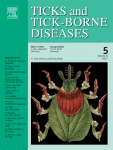Ver ítem
- xmlui.general.dspace_homeCentros Regionales y EEAsCentro Regional Santa FeEEA RafaelaArtículos científicosxmlui.ArtifactBrowser.ItemViewer.trail
- Inicio
- Centros Regionales y EEAs
- Centro Regional Santa Fe
- EEA Rafaela
- Artículos científicos
- Ver ítem
Different lines of evidence used to delimit species in ticks : a study of the South American populations of Amblyomma parvum (Acari: Ixodidae)
Resumen
The goal of this work was to combine different lines of evidence besides that of molecular markers to delimit species in ticks when the molecular data are not totally congruent. Two groups (Argentina, Brazil) of South American populations of Amblyomma parvum were compared to test whether the splitting of these two lineages suggested by genetic analyses is complete. Comparative studies of reproductive compatibility, morphological analyses of fixed
[ver mas...]
The goal of this work was to combine different lines of evidence besides that of molecular markers to delimit species in ticks when the molecular data are not totally congruent. Two groups (Argentina, Brazil) of South American populations of Amblyomma parvum were compared to test whether the splitting of these two lineages suggested by genetic analyses is complete. Comparative studies of reproductive compatibility, morphological analyses of fixed characters, and comparison of population distributions in spatially defined ecological niches were performed.The morphological comparisons of both discrete and morphometric characters showed no differences among A. parvum ticks from Argentina and Brazil. The intercrosses and backcrosses showed evidence of pre- and post-zygotic compatibility between the two groups. No significant differences in environmental traits were found which would justify the separation of the records of A. parvum in distinct groups. Although the gene flow between the two groups of populations is limited, the absence of reproductive barriers, the lack of significant morphological differences, and the absence of significant differences in the niche preferences indicate that populations of A. parvum from Argentina and Brazil should be treated as a single species. The speciation conjectures suggested by some analyses of mitochondrial DNA sequences were not supported when different lines of evidences were compared.
[Cerrar]

Autor
Nava, Santiago;
Gerardi, Monize;
Szabó, Matías P.J.;
Mastropaolo, Mariano;
Martins, Thiago F.;
Labruna, Marcelo B.;
Beati, Lorenza;
Estrada-Peña, Agustín;
Guglielmone, Alberto Alejandro;
Fuente
Ticks and tick-borne diseases 7 (6) : 1168-1179. (2016)
Fecha
2016-10
ISSN
1877-959X
Formato
pdf
Tipo de documento
article
Palabras Claves
Derechos de acceso
Restringido
 Excepto donde se diga explicitamente, este item se publica bajo la siguiente descripción: Creative Commons Attribution-NonCommercial-ShareAlike 2.5 Unported (CC BY-NC-SA 2.5)
Excepto donde se diga explicitamente, este item se publica bajo la siguiente descripción: Creative Commons Attribution-NonCommercial-ShareAlike 2.5 Unported (CC BY-NC-SA 2.5)

